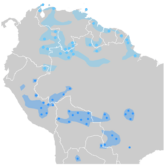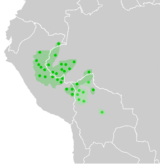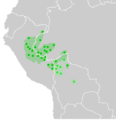Origin of the Mapuche facts for kids
The origin of the Mapuche people has been a mystery for over a hundred years. Scientists and historians have studied their genes, language, and ancient tools to find out where they came from. The Mapuche people's genes don't clearly match any other known Native American group. Their language, Mapudungun, is also unique and is called a language isolate. This means it doesn't seem to be closely related to any other language family.
Archaeological finds show that Mapuche culture has existed in Chile since at least 600 to 500 BC. While they arrived later in southern areas like the Chiloé Archipelago and eastern areas like the Pampas, their history in the north, near the Atacama Desert, might be even older. The Mapuche people were influenced by older cultures like the Tiwanaku and Inca, and later by the Spanish. However, their deep roots go back much further than these contacts. Many experts believe that their conflicts with the Spanish Empire during the Arauco War greatly shaped who the Mapuche are today.
Many researchers think the Mapuche people are originally from the land they live on (autochthonous). Some studies of their genes, old artifacts, and language even suggest a possible connection or influence from the Amazon rainforest a very long time ago.
Contents
Where Did the Mapuche Come From?
For a long time, people have wondered about the Mapuche origins. Different ideas, called hypotheses, have been suggested.
Early Ideas About Mapuche Migration
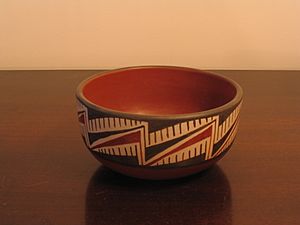
One early idea, proposed by Ricardo E. Latcham, suggested that the Mapuche people moved to what is now Chile from the Pampas grasslands, which are east of the Andes mountains. This idea also claimed that before the Mapuche, another culture called "Chincha-Diaguita" lived there. The Mapuche supposedly split this culture in half by moving through mountain passes near the Cautín River. While this idea matched some language patterns, modern experts don't agree with it because there isn't enough strong proof.
Another idea came from Tomás Guevara. He thought that early Mapuche people lived along the coast. They used the ocean's resources and later moved inland by following large rivers. Guevara also suggested that Mapuches might be descendants of the northern Changos, who were a coastal group not well known today. There's a small hint of a language link between 19th-century Changos and Mapudungun.
Clues from Archaeology and Place Names
Archaeology is the study of human history through digging up old things. These finds help us understand the past.
Ancient Discoveries and Mapuche Culture
Experts like Alberto Trivera believe there's no direct link between the ancient human culture found at the Monte Verde site (from the Late Pleistocene ice age) and any known historical group. However, archaeological discoveries show that Mapuche culture existed in Chile as early as 600 to 500 BC. In 1954, Grete Mostny suggested a connection between Mapuches and the El Molle culture in the Transverse Valleys of Norte Chico. The Mapuche Pitrén ceramics (pottery) appeared a little after El Molle pottery and share some similarities.
Some archaeologists think the El Molle culture is related to cultures in the Argentine Northwest. These cultures, in turn, might be linked to "tropical jungle" cultures further north. Small lip piercings called Tembetás, often seen in Brazilian indigenous cultures, have been found in Central Chile. Experts debate if these came from migrations or other ancient connections with the Argentine Northwest.
Mapuche Names in the Landscape
Mapuche communities in southern Norte Chico, like those in Petorca, La Ligua, Combarbalbal, and Choapa, might have roots going back centuries before the Spanish arrived. Many place names in this area are also Mapuche. Even though some Mapuches moved to the southern Diaguita lands during colonial times, the Mapuche culture there is thought to be much older. Further north, along the coast of the Antofagasta Region, there are also place names believed to be Mapuche, including Taltal and Quebrada Mamilla.
Ancient farming methods used by the Mapuche, like growing crops in canalized fields and raised fields, suggest these techniques might have come from either Lake Titicaca in the Altiplano mountains or the Amazon lowlands.
The Mapuche arrived later in the Chiloé Archipelago. Even though the main language there when the Spanish arrived was Veliche (a Mapuche language), many place names have Chono origins. This supports the idea that the Chono people and other sea-faring nomads might be what's left of older groups who were pushed south by new tribes moving in from the north.
Genetic Clues to Mapuche Origins
Studying genes can tell us about how different groups of people are related.
Mapuche Genes and Other Groups
Genetically, Mapuche people are different from the indigenous groups living nearby in Patagonia. This suggests they either have a different origin or have been separated from Patagonian populations for a very long time. A study in 1996 looked at the genes of indigenous groups in Argentina and found no strong link between Mapuches and other groups.
However, a 2019 study on the genes of Mapuche people from Cañete found some similarities with various Native American groups from both North and South America. Interestingly, this study also found connections with Aleuts, Eskimos, Pacific Islanders, Ainu from Japan, Negidals from Eastern Siberia, and Rapa Nui from Easter Island.
Based on mDNA analysis, which traces the mother's side of the family, some experts believe that Mapuche people are partly descended from groups in the Amazon Basin. These groups might have migrated to Chile through two routes: one through the central Andes mountains and another through the eastern Gran Chaco and the Argentine Northwest.
Language Connections of Mapudungun
There is no clear agreement on which language family Mapudungun, the Mapuche language, belongs to. In the early 1970s, some researchers suggested strong links between Mapuche and Mayan languages. In 1978, linguist Mary Ritchie Key claimed that Mapuche languages were related to the Pano-Tacanan languages, the Chonan languages, and the Kawéskar languages.
Later, Croese (1989, 1991) suggested that Mapudungun is related to the Arawakan languages. The Mapuche word for "stone axe" is toki, which is similar to totoki ("axe") in the Yurumanguí language from Colombia.
Mapuche language shares many words with Quechua, Aymara, and Puquina. However, this likely shows a later influence from Andean cultures and possibly migrating groups on the Mapuche people who were already there. This linguistic influence might have arrived with a wave of migration after the Tiwanaku Empire collapsed around 1000 CE. Jolkesky (2016) believes that Mapuche's word similarities with the Kunza, Mochika, Uru-Chipaya, Arawak, Pano, Cholon-Hibito, and Kechua language families are due to contact between these groups.
How the Mapuche Became a United Group
Historians believe that important events helped shape the Mapuche into a single ethnic group.
The Impact of Inca and Spanish Conflicts
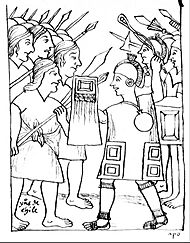
One major step in the Mapuche becoming a united people might have been their contact with Inca invaders. This contact made them realize they were different from the invaders. It also helped unite them into loose groups, even though they didn't have a formal state organization.
Many historians, like José Bengoa, believe that the Mapuche truly became a single ethnic group during the Arauco War against the Spanish. Experts Tom Dillehay and Francisco Rothhammer say that archaeological evidence supports this idea. It shows that scattered indigenous populations started living in more crowded areas because of the warfare.
Mapuche Beliefs and Stories
The Mapuche people also have their own ideas and oral traditions about where they came from.
Stories of Origin
Some Mapuches who live near the coast believe their ancestors arrived from the sea. Other Mapuches say they are descended from the people who lived at Monte Verde, which is the oldest archaeological site found in Chile.
Images for kids
See also
 In Spanish: Origen de los mapuches para niños
In Spanish: Origen de los mapuches para niños



